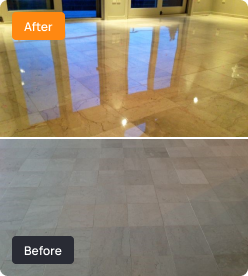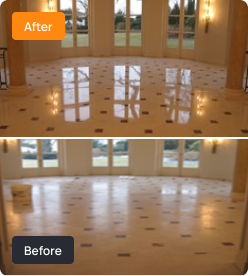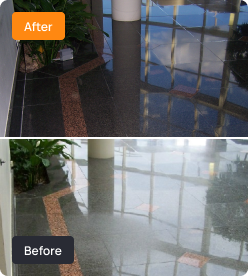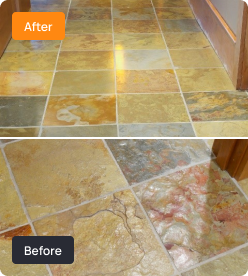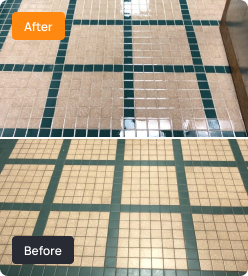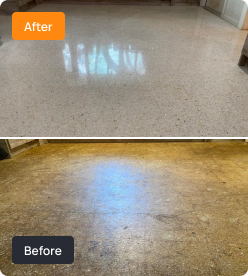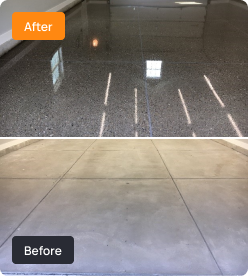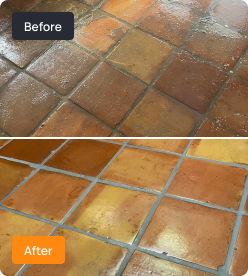Marble & Travertine Care
Marble is an elegant surface with plenty of character. Keeping it looking that way requires special care. The following sections will help you gain a basic understanding of what you have and how best to keep it looking great.
Let’s take a closer look at how we enhance and preserve your Marble and Travertine surfaces.
Identification & Care of Marble, Travertine & Terrazzo
Marble is a beautiful many colored natural surface with lots of veining for character and accents. It is best recognized by its veined structure and appearance. You can see the splash of color and contrast the veining provides in these images. You can almost see the layers of sediment that have built this stone, and the history of breaking and reforming to allow different color sediments to make their contribution to a natural unique masterpiece.
Travertine is a type of marble that exhibits very large open pockets created by gas trapped during the fermenting of sea creatures from ages gone by. This is great for providing a rustic look (and even a few fossils if you are lucky). Travertine will come in an OPEN (with holes) and FILLED format where the pockets have been filled prior to polishing. You will notice these as solid uniform colored spots that look different than the rest of the stone such as what you see in these photos. If you have to clean the floor you can imagine why CLOSED is the preferred variant, and why so many companies and home owners will contact MARBLELIFE to convert it from OPEN to CLOSED after a few months of digging dirt out of these holes. Travertine is cared for same as marble and is included in this marble section.
Caution: Marble is largely made of calcium carbonate, the same chemical used in chalk and your ant-acid. Acid will eat the calcium out of the marble causing a damaged spot called an etch. Want to see what we mean? Drop an antacid into some vinegar or Cola and watch as the acid dissolves away the Calcium Carbonate. We think of acids as dangerous items, but you may be surprised to learn that it is all around you including in your coffee, sodas, most fruit juices, wine, vinegar, pickle juice, limes, lemons, oranges, many sauces, room fresheners, perfumes, glass cleaners and many cleaning products actually contain acids as well.
An etch can look like a dull spot (initially) , or the surface may have a slight uniform etch (white spot) to it once the damage goes a little deeper. The most common culprit is an erroneously recommended wives tale suggesting one should clean with a little vinegar. Its green, but not for the environment but rather your restoration companies pocket as it will take a professional visit to repair the damage.
To properly care for your marble use a high quality acid-free cleaner to keep it free from oils and debris. Keeping acids away from marble is essential for maintaining its elegant appearance. Sealing marble is highly recommended; however it will not protect the marble from acids, but it will help protect it from stains. Sealers remain WITHIN the stone, not on top of the stone, and as such provide no shielding of the surface from acids, but rather prevent foreign liquids spills, oils and discolorants from being able to get INTO the stone’s pores where you simply cannot get to them to remove them. Think about what it takes to clean out a chemistry set test tube, you just cannot do it with a sponge, mop or paper towel. Similarly, it is less expensive to seal the floor or stopper your clean test tube, then wrestle with this expensive eyesore problem later.
Marblelife Marble Polish may be used to remove etches and light scratches from marble in small areas such as counters, vanities, tables or small repairs to floors, however this is not suitable for large areas as subtle differences in finish across broad areas become very noticeable. This is a case where you want to bring in a professional and save the aggravation a DIY effort is likely to generate. Can it be done? Sure. In fact, MARBLELIFE will credit your purchase of MARBLE POLISH against your polishing bill, should you attempt this before giving them a call to repolish your surface. That said, rest assured, if you are that confident DIYer that insstes of
A gloss conditioner may be used to bring out the inner beauty of your marble tables, vanities and counters; (but should never be used on floors as gloss conditioners can negatively impact floor traction). These products deliver beautiful but temporary results. Great for popping a shine prior to guests, but for a longterm shine a professional polishing can generally deliver as high a finish but with a significantly longer life.
Terrazzo employs marble chips in a bed of concrete or epoxy, providing a beautiful durable wear resistant floor popular in schools, malls and government buildings. These floors were popular in historic homes and buildings built in the 50s, 60s and 70s. In fact, having been introduced prior to the development of in the field restoration techniques there are numerous masterpieces hidden beneath vinyl tile and old threadbare carpets in historic neighborhoods around the country. The good news is that professional restoration craftsman LOVE working on these as they are generally removing an inexpensive worn surface to FREE the masterpiece beneath it. These can make for some incredible before-and-afters, and a significant increase in home value. The change is so dramatic we often get invited to the open house that follows as the neighbors visit to see how beautifully elegant the foyer and entryways can be.
Have no fear, whatever your surface or question MARBLELIFE is a call away with a solution whether in a bottle or a person capable of restoring the elegance and beauty of your marble, terrazzo and travertine floors. Check out our web sites from around the country to see some of the projects completed. You will walk away with a comfortable feeling of what can be achieved, who can do it, and a healthy anticipation to see the results.
About Marble
Marble Countertops
Marble Showers
Marble Floor Care
Order of Care
When caring for natural stone such as Marble, Travertine & Terrazzo there is an order to things which helps to assure the best care possible based on the stones longevity and appearance.
This order is:
First – Clean your Marble regularly using the best marble cleaner available. Take steps to protect your marble from things that contain acids, such as soda, fruit and fruit juices, coffee, tea and wine. Dust and sweep to prevent grinding medium such as dust, dirt, and sand from collecting on the floor where it can be ground underfoot to create wear marks and scratches. Keep in mind just because a cleaner says it is a cleaner does not make it effective. Glass cleaners leave waxes behind. Acid cleaners and vinegar dull the stone as they dissolve the surface, and many cleaners are little more than water. We recommend MARBLELIFE Marble & Travertine Cleaner, as it has been engineered over 25 years to safely remove dirt and oil from your surface without streaking or leaving build-up. If your floors are sticky you have the wrong cleaner.
Second – Repair your Marble promptly. If you have etches, stains or cracks you have a problem. As with anything failure to address the problem can result in it getting worse. Scratches beget deeper scratches. The deeper the damage the more grinding is required to repair the floor and the more expensive the repair. A grain of sand will roll across the floor until it encounters a scratch at which point it travels down the scratch digging it deeper.
Third – Seal your Marble to help protect against stains and to help make cleaning easier. Stains scream that the floor is not sealed, and therefore open to further staining. There is no guarantee a stain can be removed, and if it can it is often a multi-step process to do so making it frustrating and expensive. Much easier and less expensive to insure your stone is sealed every couple of years.
Lastly – Conditioning to help bring out your Marble’s best appearance if needed and as desired. The fact is a well restored floor needs no conditioning as it already has the desired appearance. If you find you are looking for something to enhance the appearance of your floor, better to contact a stone craftsman to address the deficiency than to begin applying products to alter its appearance. These tend to be short-term adjustments and may result in longterm issues.
The intervals of these activities can vary greatly based on your marble’s environment. Is your Marble indoors or outdoors? Does it get high traffic or very little use? With this said here are some general guidelines.
Consult a MARBLELIFE craftsman to get specific recommendations for your property and surfaces:
- Cleaning should be done regularly between daily (hotel) to weekly.
- Repairs should be done as needed and a promptly as possible. Just as you have an AC guy, and a vet for your pets, you want to have a craftsman for you stone that you are comfortable working with.
- Sealing should be done regularly, typically every two years, however if your surface has been cleaned with an acidic cleaner it can damage your seal and shorten your re-seal time.
- The need to condition should be considered the need to contact a craftsman to discuss either your changing finish preference, or the need to restore the floor to the condition you are seeking. Your stone can be adjusted to provide a matte, satin, semi-gloss, or gloss finish as desired.
Again these are very general intervals to help give some frame of reference.
Similar Quick Tips
Explore AllDusting With MARBLELIFE’S Intercare Cleaner
https://youtu.be/K_URZctzGx8For dusting with InterCare, lightly spray InterCare onto a microfiber or other type of towel then begin dusting. InterCare provides a light cleaning action while you are removing the dust and aids in keeping the dust on the towel. Use...
ExploreCleaning With MARBLELIFE’S Intercare Cleaner
https://youtu.be/FpQekPRsy7s Save Time & Money with Marblelife's InterCare Cleaner You can now save time, save money and use fewer products, by using MARBLELIFE InterCare and a microfiber towel. You can dust, clean windows, remove oily hand prints from glass doors and...
ExploreLeather, Fabric & Carpet Care
https://youtu.be/a4_XcL9EZdwThe cleaning of Leather, Fabric, and Carpet can be done with MARBLELIFE® InterCare Cleaner and a clean cloth. First, test it on an inconspicuous area to make sure that the die used on the leather is good and does not...
ExplorePainted & Plastic Surfaces Care
https://youtu.be/UQEPCI4FfRMInterCare is a fantastic cleaner for nearly every surface that you can use water on including painted surfaces and plastics. Designed to effectively remove oils and oily residues, this cleaner is exceptional in removing oily hand and fingerprints. Whether using...
Explore

